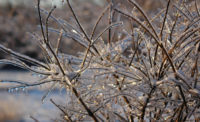Stay warm this winter with FR protection plan
Chill factor

As we reach the cold depths of winter, it’s important to consider workplace hazards and FR protection. Consider a winter PPE plan for workers in cold-weather areas who may be exposed to arc flash and other conditions that require FR protective clothing. Although OSHA doesn’t have specific standards for cold weather winter wear to protect against arc flash, it requires employers to protect employees from the hazards present in the workplace.
It might be helpful to consider the following when selecting the right FR protection to stay safe this winter:
Check the weather
Outdoor conditions and cold weather could present dangerous situations not only with slippery ice and snow, but also reduced mental alertness and manual dexterity. Staying informed of the changing conditions will keep you safer and better protected.
Keep dry
In addition to being uncomfortable, wet clothing can cause body heat loss and injuries associated with potential arc flash. A recent arc flash study, “Addressing Comfort and Contamination in Arc Rated Clothing,” published in February 2014 by Hugh Hoagland and Mikhail Golovkov, showed that wet FR fabrics suffer a potential 50 percent reduction in Arc Thermal Protection Value when saturated with moisture.
Keeping workers dry is a critical component of keeping them safe. Moisture seeping through layers also can pose a risk. Once the clothing next to your skin becomes moist, it offers a path for an arc flash to travel. Use appropriate rain gear and have a change of FR wear available for emergencies. Workers who are exposed to electrical hazards should not wear synthetic materials that can melt.
Dress in layers
Frostbite to your hands and feet can occur quickly. Consider additional layers for gloves and boots. These will provide extra warmth and you can change the inside liners if they become damp. If you are required to wear protective gloves, liners should be made of suitable material that will not melt in case of arc flash – such as Merino wool. A clothing plan should allow for layers that can be added or removed to adjust to the external environment while still providing proper protection from any flash fire or arc flash hazards associated with the job.
Keep FR clothing clean
When your FR clothing becomes contaminated with oil, dirt or debris, you should clean it according to the manufacturer’s instructions. Allowing chemicals and oil to build up on your protective wear could increase your risk of injury since oils and chemicals could ignite.
When you follow the use and care instructions according to FR clothing manufacturers, you are getting the most from your FR products. During winter, you may need to change garments frequently if you are working in snowy or muddy conditions.
An important factor in choosing appropriate FR protection for the winter season is to select clothing that is not only suitable for the temperature in which you will be working, but is also functional for the work you will be performing and the physical exertion required. Check with NFPA 70E and NFPA 2113 for further information on selection, use and maintenance.
References:
www.lselectric.com/proper-ppe-makes-the-difference-in-an-arc-flash
Looking for a reprint of this article?
From high-res PDFs to custom plaques, order your copy today!







